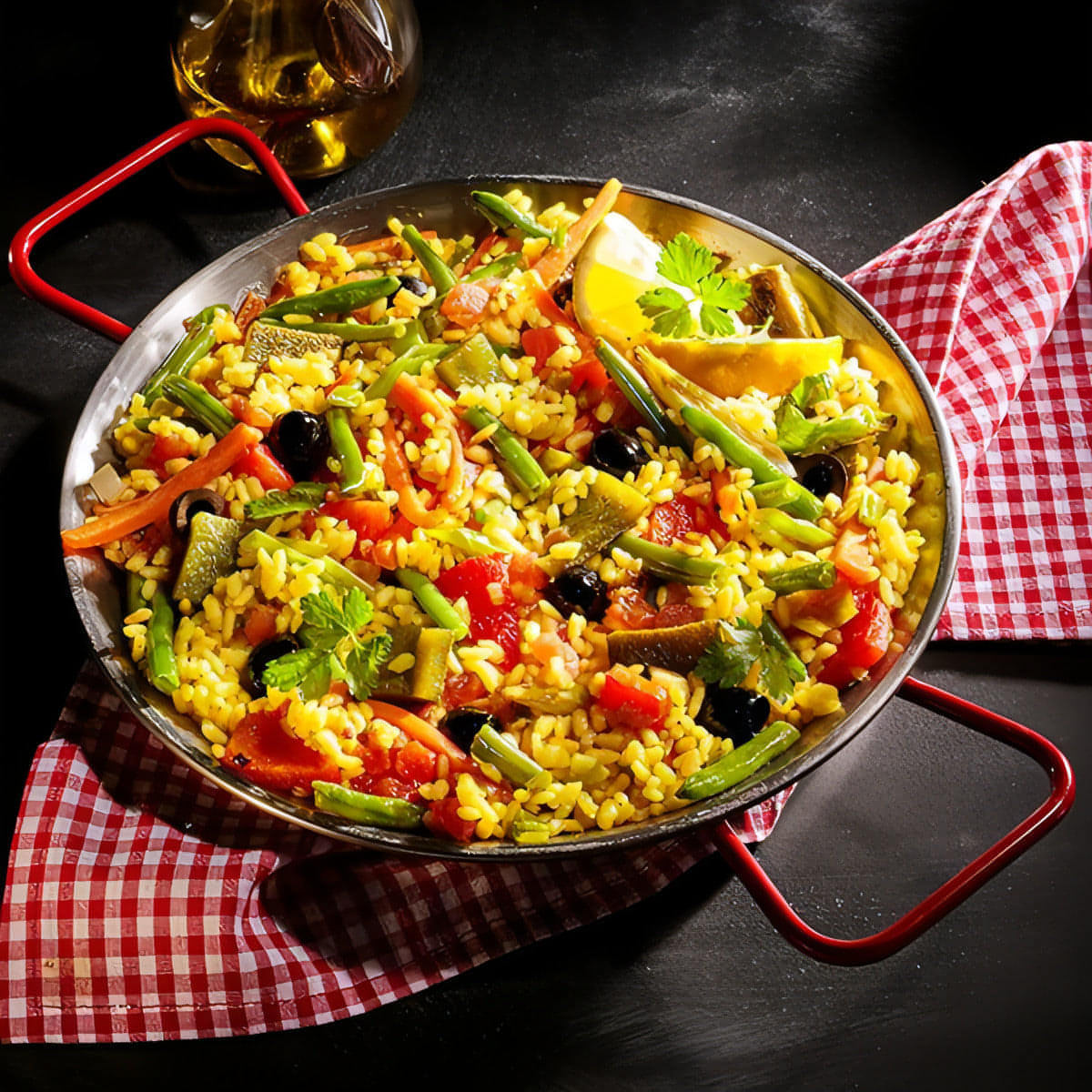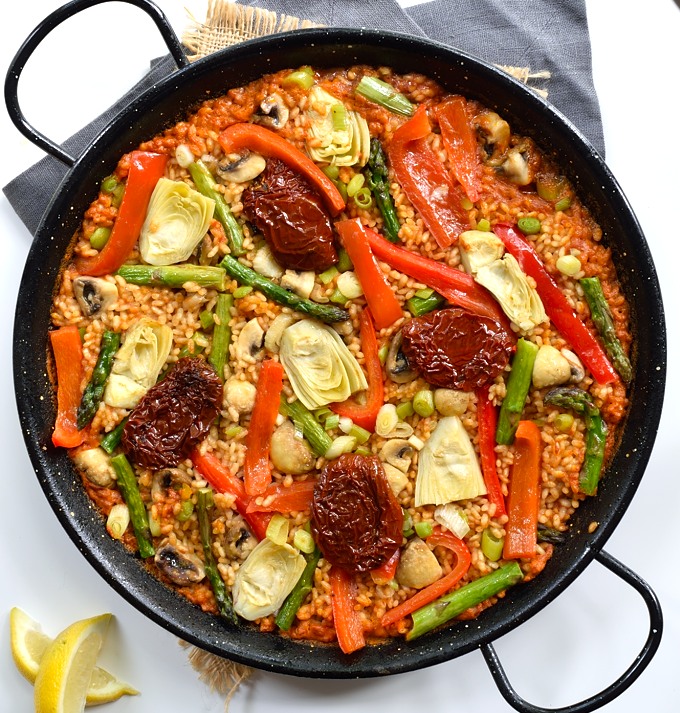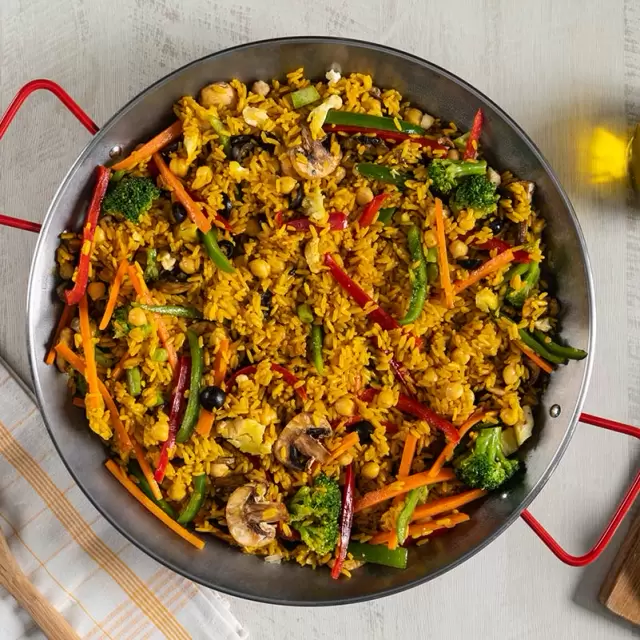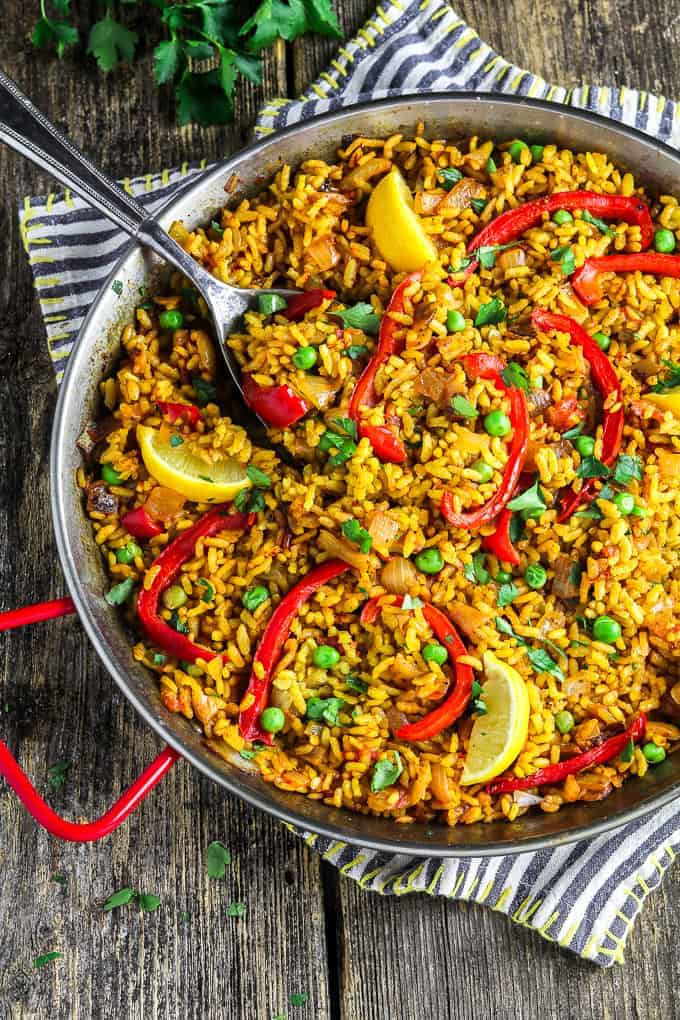On my travels, I’ve savored the rich tapestry of flavors that global cuisines offer, but it was during a sojourn in Spain that I discovered a vegetarian take on a beloved classic: Paella Vegetariana. This variant captivates with its robust ingredients like tender artichokes, creamy flageolet beans, and the comforting depth of chicken broth, each playing a pivotal role in crafting a dish that’s as satisfying as it is aromatic. Despite the absence of traditional seafood or meats, this version loses none of the essence that makes paella a centerpiece of Spanish cuisine.
Driven by a desire to replicate this flavorful medley, I delved into the nuances of paella-making. The journey was one of trial, error, and eventual triumph as I captured the essence of the artichokes’ subtle bitterness, the beans’ velvety texture, and the broth’s rich foundation. Now, I’m eager to share this recipe with you. Let’s embark on a culinary adventure together, bringing a piece of Spain’s culinary diversity to our tables with this deliciously hearty Paella Vegetariana.
Paella Vegetariana Recipe


Paella Vegetariana
Equipment
- 1 cross shape
- 1 saucepan
Ingredients
- 2 artichokes
- 6 cups of chicken broth
- 1 large eggplant
- 1 large bell pepper
- 9 ounces flageolet beans
- 2 medium tomatoes
- 4 cloves garlic
- 9 ounces white beans
Instructions
- Before preparing, soak the chickpeas night and discard the liquid.
- Thinly slice the garlic.
- Split the tomato in half and then into four pieces per half.
- Cover the lid on the grate, drizzle with enough canola oil to cover the bottom, and heat.
- Sauté the onion, ginger, and tomatoes in the canola oil until it’s hot.
- To avoid sticking, use olive oil as required.
- Add the lentils and stir to combine.
- Place the rice in a cross shape.
- Stir for two or three minutes to coat the rice completely in oil before adding the other ingredients.
- Stir everything together well.
- Stir in the saffron to the stock in the saucepan.
Cooking tips about Paella Vegetariana

- Selection of Rice: Opt for short-grain rice like Bomba or Calasparra. These types absorb liquid well and maintain texture, crucial for achieving the perfect paella.
- Saffron is Key: Saffron lends the distinct yellow color and aromatic flavor characteristic of paella. Use authentic saffron strands, allowing them to steep in warm water to release their color and essence before adding to the dish.
- Proper Pan: Use a traditional paella pan (paellera) if available, as its wide, shallow design ensures even heating and allows the rice to cook uniformly. If not, a large, shallow skillet can substitute.
- Cooking Vegetables: Sauté your vegetables like artichokes, flageolet beans, and any others you choose until they’re just tender before incorporating them with the rice. This step enhances their flavors and textures.
- The Sofrito Base: Create a flavorful sofrito by sautéing onions, garlic, and tomatoes as the foundational flavor base. This mixture should be cooked down until rich and concentrated before adding the rice.
- Liquid Ratio: Be attentive to the ratio of liquid (vegetable broth for a vegetarian version) to rice. Typically, it’s about 2:1, but this can vary slightly depending on the rice used. Adjust as needed but avoid stirring once the rice starts cooking to achieve the coveted socarrat (crispy bottom layer).
- Simmering without Stirring: After combining all ingredients in the pan, let the paella simmer gently without stirring. This method allows the rice to absorb flavors and textures properly while developing the socarrat.
- Artful Arrangement: Arrange additional vegetable toppings and lemon wedges aesthetically on top of the paella before it finishes cooking. This not only adds to the dish’s visual appeal but also to its array of flavors.
- Rest Before Serving: Let the paella rest covered with a clean towel for a few minutes off the heat before serving. This step helps to finish the cooking process and ensures that the rice achieves the ideal texture.
- Serve with Accompaniments: Traditional paella is often enjoyed with sides of aioli and lemon wedges. Offering these alongside your Paella Vegetariana lets diners customize their plate with a zesty or creamy addition.
Serving suggestions about Paella Vegetariana

- Garnish with Fresh Herbs: Right before serving, sprinkle your Paella Vegetariana with freshly chopped parsley or cilantro. This not only adds a burst of color but also brings a fresh aroma and flavor that complements the dish beautifully.
- Lemon Wedges on the Side: Offering lemon wedges on the side allows guests to add a bright, acidic touch to their paella. The citrus juice enhances the flavors and adds a delightful freshness to each bite.
- Accompany with Spanish Wines: Pair your Paella Vegetariana with a crisp, dry white wine like Albariño from Galicia or a Verdejo from Rueda. These wines complement the richness and complexity of the paella’s flavors without overwhelming them. For a red wine option, consider a light and fruity Tempranillo.
- Serve as Part of a Spanish Feast: Create a dining event by serving Paella Vegetariana alongside other Spanish dishes such as Gazpacho (a chilled tomato soup), Pan con Tomate (tomato bread), and a variety of tapas including Patatas Bravas (spicy potatoes) and Olives. This allows for a diverse and engaging meal where guests can enjoy a range of flavors and textures.
- As a Centerpiece Dish: Present your Paella Vegetariana as the centerpiece of your meal. Serve it straight from the paella pan for an authentic and communal dining experience, inviting everyone to dig in and share.
- Salad Pairing: For a lighter accompaniment, pair the paella with a simple salad dressed with olive oil and vinegar. A green salad with bits of orange and almonds could echo Spanish flavors and offer a refreshing contrast to the hearty paella.
- Offer Aioli on the Side: Aioli, a garlic-infused mayonnaise, is a wonderful addition to paella. Its creamy texture and robust flavor make it a perfect condiment for adding an extra dimension to the dish.
- Finish with a Fruit-Based Dessert: After the richness of the paella, consider serving a light, fruit-based dessert such as a citrus sorbet or a seasonal fruit salad flavored with a touch of mint and a splash of Cava (Spanish sparkling wine).
Top 5 FAQs about Paella Vegetariana

- What Type of Rice is Best for Paella Vegetariana? The ideal types of rice for making Paella Vegetariana are short-grain varieties like Bomba or Calasparra. These kinds absorb more liquid and flavor, maintaining their texture without becoming mushy, which is crucial for achieving the perfect paella.
- Can I Make Paella Vegetariana Vegan? Yes, you can easily adapt Paella Vegetariana to be vegan by using a vegetable broth instead of chicken broth and ensuring that any additional toppings or sides (such as aioli) are vegan. The main ingredients, such as artichokes and flageolet beans, are plant-based.
- Is Saffron Essential for the Dish? Saffron is key to authentic Paella Vegetariana, lending the dish its characteristic yellow color and unique flavor. While there are substitutes, using genuine saffron strands gives the dish its authentic taste and aroma.
- How Do You Achieve the Socarrat in Paella Vegetariana? The socarrat, or the crispy bottom layer of rice, is achieved by cooking the paella on a low flame without stirring once the rice begins to simmer. This allows the bottom layer of rice to caramelize and develop a crispy texture, which is highly prized in a good paella.
- Can Paella Vegetariana be Made in Advance? While paella is best enjoyed fresh, you can prepare some components ahead of time, such as the sofrito or sautéed vegetables. However, for the best texture and flavor, it’s recommended to cook the rice and assemble the paella close to serving time. Leftovers can be stored and reheated, though the socarrat may soften upon reheating.
Leave a Reply